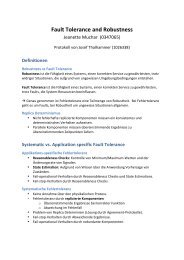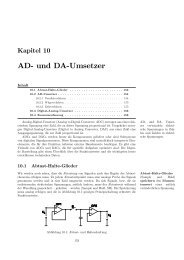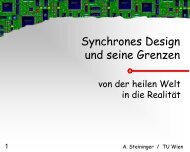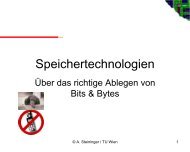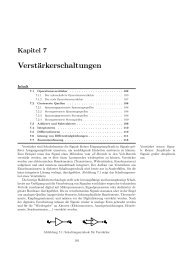Introduction to Microcontrollers
Introduction to Microcontrollers
Introduction to Microcontrollers
You also want an ePaper? Increase the reach of your titles
YUMPU automatically turns print PDFs into web optimized ePapers that Google loves.
2.2. MEMORY 31<br />
a matter of minutes. Separate memory addressing, on the other hand, comes with an implicit<br />
protection against access <strong>to</strong> the wrong type of memory.<br />
When accessing byte-addressed memory word-wise, there is a special pitfall <strong>to</strong> be considered:<br />
Suppose a 16 bit controller writes a word (two bytes) in<strong>to</strong> SRAM, say at address 0x0100. The word<br />
consists of a low and a high byte. Now, in what order are the bytes <strong>to</strong> be written? There are two<br />
variants: the low byte could go <strong>to</strong> 0x0100 and the high byte <strong>to</strong> the next address (0x0101), or the other<br />
way around. That is the problem of endianness:<br />
Big Endian: Big Endian architectures s<strong>to</strong>re the high byte first. So, if you write the word 0x1234 <strong>to</strong><br />
address 0x0100, the high byte 0x12 goes <strong>to</strong> address 0x0100, and the low byte 0x34 <strong>to</strong> address<br />
0x0101. The name is derived from this order: The Big End of the word is s<strong>to</strong>red first – therefore,<br />
it is called Big Endian.<br />
Little Endian: Little Endian architectures access memory the other way around (Little End of the<br />
word first). Here, the low byte is s<strong>to</strong>red first. Writing 0x1234 at address 0x0100 on a little<br />
endian architecture writes 0x34 <strong>to</strong> address 0x0100 and 0x12 <strong>to</strong> address 0x0101.<br />
Note carefully, however, that this difference in the ordering of high and low is only relevant on a<br />
byte level. The bits within a byte are numbered from right <strong>to</strong> left on both architectures. So, the least<br />
significant bit is always the rightmost one.<br />
2.2.4 Exercises<br />
Exercise 2.2.1 Assume that the values (1, 2, 3, 4) are s<strong>to</strong>red at the memory (byte) addresses 0, 1, 2, 3.<br />
You load the word from address 1 in<strong>to</strong> register R1 (assume that unaligned access is possible). Which<br />
(hexadecimal) value does R1 have if the architecture is big endian?<br />
Exercise 2.2.2 What are the advantages of PROM over ROM? Are there any disadvantages?<br />
Exercise 2.2.3 Why do EPROMs have a window, while EEPROMs do not have a window? What is<br />
the window used for?<br />
Exercise 2.2.4 What is the difference between an EEPROM and a Flash-EEPROM?<br />
Exercise 2.2.5 Assume you have an EEPROM that is specified for 100,000 write cycles. You want<br />
<strong>to</strong> s<strong>to</strong>re the daily exchange rate for some currency. For how many years can you use the EEPROM?<br />
Would it be sensible <strong>to</strong> put the EEPROM in<strong>to</strong> a socket <strong>to</strong> be able <strong>to</strong> exchange it easily? What if you<br />
have <strong>to</strong> update the exchange rate hourly?<br />
Exercise 2.2.6 What are the advantages and disadvantages of a RAM compared <strong>to</strong> an EEPROM?<br />
Exercise 2.2.7 Why do microcontrollers use SRAMs and not DRAMs?<br />
Exercise 2.2.8 Why does the NVRAM not copy every write access in<strong>to</strong> the EEPROM? Would that<br />
not be more secure?<br />
Exercise 2.2.9 When is an OTP memory useful? Would you put a controller with OTP memory in<strong>to</strong><br />
a cell phone?<br />
Exercise 2.2.10 Assume that you have the loop for (i=100; i>=0; i--) in your C program.<br />
The loop variable i is inadvertently s<strong>to</strong>red in EEPROM instead of SRAM. To make things worse, you<br />
implemented the loop with an unsigned variable i, so the loop will not s<strong>to</strong>p. Since the access is now<br />
<strong>to</strong> the slow EEPROM, each iteration of the loop takes 10 ms.



